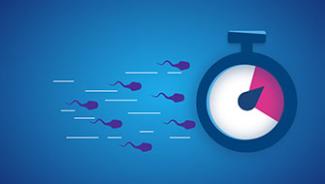
There are only a few days each cycle when a woman is fertile. Because many people don’t know when their fertile window is, one in two couples may be trying to get pregnant at the wrong time by having sex on the wrong days.1 Knowing your menstrual cycle and knowing when you ovulate can maximize your chances of conceiving. If you’d like to know more and have other questions about the best time to get pregnant, then read on.
In this article
- 1. When is the best time to have sex to get pregnant?
- 2. Can you get pregnant at any time of the month?
- 3. How can I track my fertile days?
- 4. How hormone tracking tells you when you are most likely to get pregnant
- 5. How long will it take me to get pregnant?
- 6. What is the optimal age to get pregnant?
1. When is the best time to have sex to get pregnant?
The best time to try for a baby is on the days leading up to ovulation and the day of ovulation itself (ovulation is the process when an ovary releases an egg). Since sperm can live up to 5 days inside a woman’s body, timing sex for the days leading up to ovulation can also lead to pregnancy.
There is a common myth that all women have a 28 day cycle, but this is not the case. 52% of menstrual cycles vary by 5 or more days2 so using a method to identify when you ovulate can help you conceive.
2. Can you get pregnant at any time of the month?
No, you will need to have sex on the days leading up to and around the time you ovulate. Your most fertile days are the day before and day of ovulation. Once you’ve ovulated, the egg will only survive for up to 24 hours if unfertilitized. Methods that only tell you you’ve ovulated (after you’ve released an egg) won’t optimize your chances of getting pregnant that cycle because by the time you know it’s happened, it’s too late for it to be fertilized. However, knowing you’re about to ovulate on the other hand will. .
3. How can I track my fertile days?
Tracking your most fertile days can help you plan when to have sex to get pregnant. Below is a summary of some of the methods available:
- Track your hormones
An accurate way to identify your fertile days is to monitor your hormones. When there is an LH (luteinizing hormone) surge, it means you are about to release an egg in the next 24 to 36 hours, so an ovulation test which detects your LH surge lets you know when your 2 most fertile days are. Other ovulation tests also detect the rise in estrogen which occurs before the LH surge, identifying your wider fertility window. - Use an app or wearable
Apps and some wearables (such as fitness tracking devices) use the calendar method to identify your fertile days. Tracking the length of your menstrual cycles can help build up a picture as ovulation typically occurs between 12 and 15 days before your next period starts. However, cycle lengths can vary and ovulation can vary even in regular cycles. Other wearables use basal body temperature (BBT) to calculate your fertile days. - Look for changes in BBT
The temperature of your body at rest will go up slightly after you ovulate. If you measure your body temperature every morning before you get out of bed and track this you’ll notice a pattern emerging. Since you are at your most fertile two or three day before your BBT rises, you’ll only know you've released an egg once it's too late. - Look for changes in vaginal secretions.
Monitoring your vaginal discharge can also tell you about your most fertile days. Just before you release an egg, the consistency of your cervical mucus may be clear, wet, and stretchy, and more sperm- friendly. After ovulation, it becomes thicker, cloudy, and less visible. Using these symptoms to track fertility can be unreliable and is best done with expert training. You should see your doctor if you have any abnormal discharge.
4. How hormone tracking tells you when you are most likely to get pregnant
Tracking hormones is an accurate way to identify your fertile days and help you get pregnant.
An increase in the level of estrogen occurs before ovulation and identifying this rise indicates you have an increased chance of getting pregnant. Estrogen causes the lining of your uterus to change to support a fertilized egg should you become pregnant. It also changes the consistency of your cervical mucus to make it more sperm-friendly.
The rise in estrogen triggers the release of another hormone, luteinizing hormone (LH). This surge of LH typically occurs 24 to 36 hours before ovulation – the process when an egg is released from an ovary. Identifying the LH surge indicates the onset of the 2 most fertile days, when you are most likely to get pregnant.
Most ovulation tests detect the LH surge identifying your 2 most fertile days. You can also get ovulation tests that detect the rise in estrogen so you can identify a wider fertility window.
5. How long will it take me to get pregnant?
Some women will get pregnant quicker than others. In fact, for up to 40% of women it took more time than expected to get pregnant3, but more than 80% of couples will usually conceive within a year if they are having regular sex.4
The time it takes to get pregnant depends on factors such as
- age
- health
- family and medical history.
Most experts recommend women see a doctor if they cannot conceive within a year if they are under 35. If you are aged 35 or more, then see your healthcare provider if you cannot conceive within six months of trying5. If you are over 40 should see your doctor straight away.
6. What is the optimal age to get pregnant?
A woman’s fertility declines with age. So, your 20s is when you’re most likely to be fertile and you have the best odds of getting pregnant. But you don’t need to get pregnant in your 20s (and if you are in your 30s there is still plenty of time). In fact, according to the CDC, the rate of women giving birth in their 30s is at a higher rate than women in their 20s6. So, if you are not in your 20s, you haven’t missed the boat: You can still go on to have a healthy baby and get pregnant over 35; its worth speaking to your doctor to give yourself the best chance of conceiving.
Trying for a baby is one of the most exciting times for in a couple’s life and knowing your body and when you are at your most fertile can help you get pregnant more quickly.
- Johnson SR., et al. Hum. Repro. (2011) 26: i236
- Soumpasis I et al (2020) Human Reproducution Open.
- Study of 5000 women in US, UK, Germany, Italy and China (2018)
- NICE Clinical Guideline CG146 (2013) www.nice.org.uk/guidance/CG156
- https://www.cdc.gov/reproductivehealth/infertility/index.htm, updated 16 January 2019
- https://www.cdc.gov/nchs/data/vsrr/report002.pdf published June 2017

Advanced digital ovulation test
In every cycle there are only a few days when a woman can conceive, so having sex on these days is very important if you are trying to get pregnant. The Clearblue® Advanced Digital Ovulation Test is the first and ONLY test that typically identifies 4 or more fertile days each cycle.

How to get pregnant faster?
Having sex at the right time of your cycle is key, so identifying your fertile days with an ovulation test will help you get pregnant faster.




